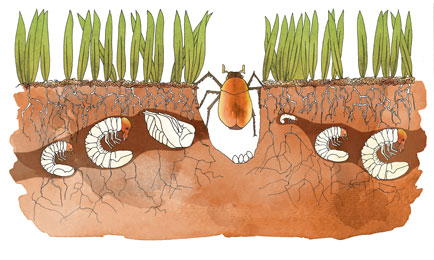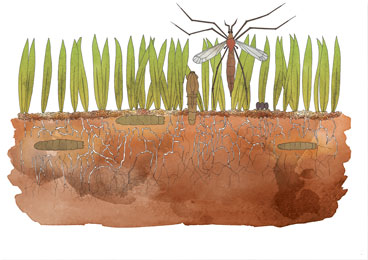
What are Chafer Grubs?
Chafer Grubs are the larvae of the Chafer Beetle
Chafer Beetle Facts:
- Chafer grubs are the larvae of at least five different species of chafer beetle. These grubs live in the soil just beneath the lawn. Both larvae and adult beetles can attack the grass plant. Chafer grubs are C-shaped, soft white larvae, up to 40mm long with a brown head and six legs on the upper end of the body.
- Commonly active during the late summer to autumn period.
- Chafer grubs feed on the roots, stems and sometimes leaves of the grass plant. The grass may appear yellow or brown before wilting and dying.
- Secondary damage from birds, badgers, foxes, moles and other small mammals searching, pecking or digging for larvae will be evident on your lawn.

Solution
- Monitor your lawn in the autumn for larvae activity and secondary damage.
- Call Lawnguard to advise. We have a treatment for this common problem
What are Leatherjackets?
Leatherjackets are the larvae of the Crane fly (Daddy long legs)
Leatherjacket Facts:
- The adult Crane Fly has long legs with a body about 25mm long.
- Commonly active in the late summer to autumn period with each female laying 200-300 eggs.
- The eggs hatch into larvae, called leatherjackets within about 14 days and remain in the soil for about 9 months before pupating into next season’s Crane Fly.
- The Leatherjacket exists in the soil from the autumn to the following spring in your lawn, by eating the stems of your grass plants. This results in the lawn beginning to turn yellow and die back in areas.
- Damage generally becomes noticeable during the spring caused by the feeding that occurred the previous autumn and winter.
- Secondary damage from birds, badgers, foxes, moles and other small mammals searching and pecking for larvae may become evident.

Solution
- Keep a look out for Crane Fly activity throughout the late summer.
- Monitor your lawn in the autumn for larvae activity and secondary damage.
- Call LawnGuard for advice. We have a treatment for this common problem